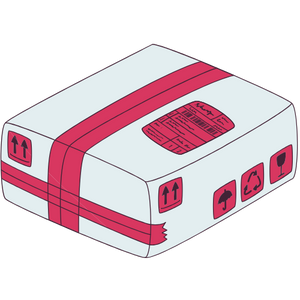More painful than PMS, discover PMDD
Depressed mood, irritability, random cravings, mood swings—our hormonal cycle and hormone fluctuations throughout, especially right before our period, can really make us feel… off! Even when everything in life is fine, suddenly nothing feels right. It’s hard to focus on work, dark thoughts creep in, and you cry at the drop of a hat. Thankfully, this doesn’t last! From a few hours to a few days, you’ve probably experienced PMS.

At Louloucup, we care about women’s mental health. Let’s talk about a more severe form of PMS, PMDD. Behind this acronym is premenstrual dysphoric disorder, a psychiatric illness.
Who is affected by PMDD? How does PMDD manifest? What are the solutions to relieve premenstrual dysphoric disorder?
🌸 Menstrual cycle, luteal phase, and PMS
During a woman’s menstrual cycle or hormonal cycle, in the luteal phase (the last phase of the cycle, between ovulation and menstruation), PMS or premenstrual syndrome can occur. As we’ve discussed before, PMS is a set of psychological and physical symptoms that women may experience before their period starts.
These symptoms can range from a “simple” headache to a mix of negative moods that are hard to handle (anxiety, apathy, discouragement, irritability, etc.).
The list of PMS symptoms is very long—health professionals have identified over 150 in total. So there’s a wide range.
Symptoms can include:
- physical symptoms (breast pain, joint pain, headaches, abdominal cramps, nausea, acne, cravings, hot flashes, digestive changes, etc.)
- whether psychological (stress, anger, feeling down, easy tears, hypersensitivity, mood swings, unexplained lack of confidence, insomnia, low libido, trouble concentrating, etc.)
These symptoms don’t always show up the same way from cycle to cycle, which makes diagnosis even more complicated.
🌸 PMDD, explained
PMDD can be described as PMS amplified many times over. While PMS is already difficult to cope with, PMDD is completely debilitating and can paralyze a woman’s entire day.
Premenstrual Dysphoric Disorder is a chronic psychiatric illness that prevents a woman from going about her day as usual—she can’t work, handle daily tasks, or participate in regular activities. PMDD has a severe impact on a woman’s everyday life (professional, family, romantic, and social) and her overall mood.
PMDD is a version of PMS with much more severe, intense, and paralyzing psychological and psychiatric symptoms.
PMDD is very different from PMS. They are not the same at all. It’s also different from PCOS, more typical menstrual disorders, or endometriosis.
🌸 What are the main symptoms of PMDD?
Some symptoms are typical when talking about PMDD:
- anxiety;
- a clearly marked depressive mood, the person is overwhelmed by dark and negative thoughts (depressive disorders);
- a feeling of anger and a very irritable mood;
- and emotional lability (unstable, sudden, or disproportionate moods).
But also:
- a loss of interest in things or activities you normally enjoy;
- sleep disorders (insomnia or hypersomnia), which don’t help with…
- lethargy and general fatigue;
- appetite disorders;
- concentration problems.
🌸 How does PMDD manifest?
As you’ve probably gathered, PMDD appears during the luteal phase and is closely linked to hormone levels (estrogen and progesterone).
PMDD can make a woman who is usually happy and fulfilled become irritable, anxious, and depressed right before her period. Women with this condition often don’t recognize themselves and feel like they’re losing control. PMDD is therefore a source of severe mental distress.
PMDD starts right after ovulation and disappears when your period begins. It can last several days (from 1 to 10 days). A woman can experience premenstrual dysphoric disorder at any point in her life.
🌸 Who is affected by PMDD?
PMDD most often appears between ages 30 and 35. This psychiatric condition affects between 2% and 8% of women of reproductive age, from puberty to menopause.
🎀 What solutions are there to relieve PMDD?
You’ve probably heard plenty of tips for managing PMS like eating better, exercising, or avoiding stress. But what about PMDD? Are there any specific treatments? Are there any tips or tricks to help you get through the luteal phase if you have PMDD?
🎀 PMDD is a recognized mental and gynecological disorder
Since this disorder is recognized as a mental and gynecological illness, both psychiatrists and gynecologists are qualified to diagnose PMDD. You still need to find a professional who is knowledgeable about this condition. Diagnosis is made if you notice and record symptoms during two consecutive menstrual cycles.
🎀 The treatments available to help relieve PMDD
There is currently no medication dedicated to treating PMDD. However, women affected can address their various symptoms in several ways:
- with synthetic hormones or a contraceptive (especially to help with psychological issues and mood disorders),
- with antidepressant use,
- with cognitive and behavioral therapies (psychotherapy),
- through a healthier lifestyle (exercise, relaxation, avoiding alcohol, coffee, etc.)
In addition to your gynecologist and psychiatrist, an endocrinologist, nutritionist, psychologist, as well as a naturopath and sophrologist, can be very helpful!
🎀 Get informed and don’t go through it alone
Think you might have premenstrual dysphoric disorder (PMDD)? You’re not alone! While this psychiatric condition is still not widely known, awareness is growing. The TDPM France Association can help with support groups, online resources, and testimonials to help you better understand what’s happening and give you the tools to cope with this difficult part of your cycle.




























